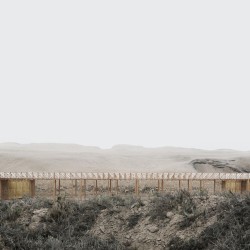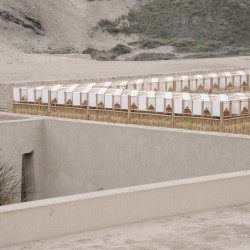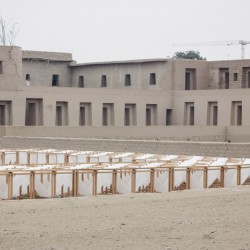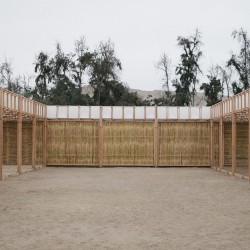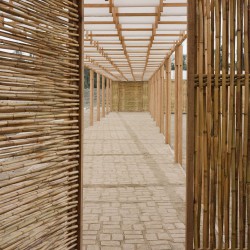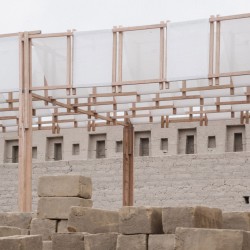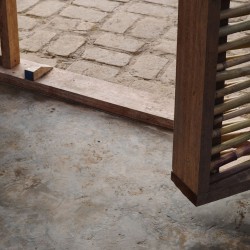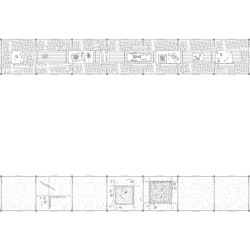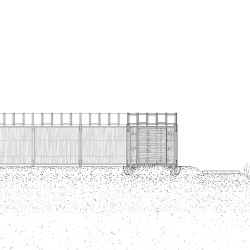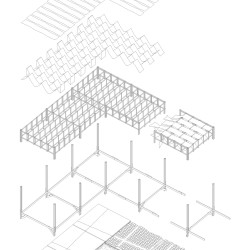Studio Tom Emerson . pucp Lima
Some forty-five students from t5 Juillerat/Manrique at the Facultad de Arquitectura y Urbanismo, pucp Lima and Studio Tom Emerson at eth in Zurich under the guidance of Guillaume Othenin-Girard collaborated on a six-month investigation that culminated in a design and build project. Together they produced a structure for archaeologists and children to come together to discover the hidden history of Pachacámac. In this new structure, Archaeologists make their first examination of artefacts emerging from the digs, shaded from the punishing Peruvian sun and in view of the passing visitors and school children, who in turn perform their own exploration in the sandpits across the courtyard. At each end of the courtyard, new finds are stored in rooms enclosed by woven cane walls before being transferred to the archaeological museum for permanent conservation. The structure was collaboratively designed and constructed by the students in three weeks in July 2018, following a research programme earlier in the year resulting in the Pachacámac Atlas.
The archaeological site of Pachacámac is a most extraordinary constructed landscape. Situated on the outskirts of Lima, Pachacámac covers about 600 hectares of land. The pre-Columbian citadel made up of adobe and stone palaces was first settled around a.d. 200 and flourished for about 1300 years to become one of the biggest and most important of these complexes in Peru. The site is the host of numerous layers of civilisation, overlapping each other at this important node of the Qhapaq Nan network of Inca trails, connecting the Pacific Ocean to the Andes. Thus, it represents the full transect of the Peruvian landscape, from the mountains to the coast.
The northern two thirds of the site comprise unexcavated open land awaiting future studies; this monumental area is a significant archaeological site with active excavations and on going discoveries of artefacts and architectural remains. With the construction of the National Museum of Archaeology underway, the government aims to restore this stretch of land to its former grandeur by transforming the site into a new centrality, embedded within the urban-fabric of the city of Lima. Yet Pachacámac is currently perceived as a void, a patch of open-desert inhabited by ruins, caught between the baffling growth of the capital and the mouth of the Lurin River–the last remaining agricultural valley of the region. Its edges are constantly under the threat of encroachment by informal settlements, such as the Julio Cesar Tello neighbourhood, or land invasions, the latest of which as recent as May 2015.
_
·
Given the proximity to Lima and the inevitable encroachment of the city into the territory, the project compelled us to ask how a culture can live with ruins, to comprehend what they represent, without being suffocated by their monumental presence. In order to restore the balance between the urban, the natural, and the cultural heritage in the city of Lima, the focus of conservation must shift from the mere preservation of physical archaeological sites, which have lost their meaning and value for the inhabitants; towards revealing and making legible the ancient knowledge embedded in their built heritage and their relation to the territory.
The Room for Archaeologists and Kids, collectively designed and built by students from the Department of Architecture at the Pontifical Catholic University of Peru pucp and Studio Tom Emerson eth Zurich, concludes a six month long collaboration on the archaeology of the territory.
The first phase after the Atlas was a 48-hour design workshop in groups of three based around site proposed by the director of the Museum, Denise Pozzi-Escot and the available materials. The workshop was a way of exploring the widest field of ideas before coming together around a single strategy. We selected a project to provide a direction to which we added elements of other proposals in order to complete the design. The constraints presented by site and material means were not thought of as barriers but as generators for design. Timber was our main structural material. The success of the group proposals lay in the simplicity of construction and relationship to other materials such as adobe bricks, woven cane and plastic textiles.
The final phase was the most intellectually and physically demanding — the construction itself. We had just under three weeks to complete the task. The team was the greatest asset but to organise nearly 45 people to work effectively was challenging. Anticipating the sequence and physicality of work was as important as any conceptual or aesthetic decisions.
The collaboratively built structure structure will support the social outreach programme of the archaeologists based at the Museum of Pachacámac.
_
A Collaboration between Studio Tom Emerson eth Zurich and the Facultad de Arquitectura y Urbanismo, pucp Lima. Research and survey, 17 – 23 March 2018, Design and Build Project, 18 June – 12 July 2018.
Project leaders: Guillaume Othenin-Girard (ETHZ), Vincent Juillerat (PUCP)
Team: Tom Emerson, Guillaume Othenin-Girard, Philip Shelley, Vincent Juillerat, Renato Manrique
Students of ETH Zurich: Turi Colque, Lucio Crignola, Gabriel Fiette, Shen He, Severin Jann, Jens Knöpfel, Tamino Kuny, Sara Lazarevic, Stefan Liniger, Juliette Martin, David Moser, Géraldine Recker, Ellen Reinhard, Sara Sherif
Students of PUCP Lima: Keicko Aliaga, Gianmario Alva, Maria Andia, Ximena Arevalo, Valeria Armijo, Andrea Avendaño, Sebastian Blas, Daniela Cahuana, Martin Cevallos, Luis Miguel Enriquez, Diana Farje, Rosa Grados, Paola Medina, Arturo Meza, Andrea Montani, Nicolle Murrugarra, Valeria Namuche, Brigith Nuñez, Sebastian Ortiz de Zevallos, Milagros Ramos, Erika Ramos, Anahy Rimachi, Diego Rojas, Brenda Salcedo, Andrea Tezen, Angie Tipe, Carla Zegarra
Museum team: Denise Pozzi-Escot, Rommel Ángeles, Janet Oshiro Rivero, Carmen Rosa Uceda Brignole, Rocio Villar Astigueta
Engineer: Andrea Biancardi, ETH Zurich
Timber construction experts: Jonatan Egli, Francisco Otero Berta
Timber: Remasa El Pina
Groundwork: Lbc Construcciones
Scaffolding: Ángeles Arquitectura de Eventos
Construction: Ángeles Arquitectura de Eventos


